

Compact Muon Solenoid
LHC, CERN
| CMS-EXO-22-019 ; CERN-EP-2024-053 | ||
| Search for long-lived heavy neutrinos in the decays of B mesons produced in proton-proton collisions at $ \sqrt{s} = $ 13 TeV | ||
| CMS Collaboration | ||
| 7 March 2024 | ||
| JHEP 06 (2024) 183 | ||
| Abstract: A search for long-lived heavy neutrinos (N) in the decays of B mesons produced in proton-proton collisions at $ \sqrt{s} = $ 13 TeV is presented. The data sample corresponds to an integrated luminosity of 41.6 fb$ ^{-1} $ collected in 2018 by the CMS experiment at the CERN LHC, using a dedicated data stream that enhances the number of recorded events containing B mesons. The search probes heavy neutrinos with masses in the range 1 $ < m_\mathrm{N} < $ 3 GeV and decay lengths in the range 10$^{-2}$ $ < c\tau_{\mathrm{N}} < $ 10$^{4} $ mm, where $ \tau_\mathrm{N} $ is the N proper mean lifetime. Signal events are defined by the signature B $\to \ell_{\mathrm{B}} $NX; N $ \to \ell^{\pm} \pi^{\mp} $, where the leptons $ \ell_{\mathrm{B}} $ and $ \ell $ can be either a muon or an electron, provided that at least one of them is a muon. The hadronic recoil system, X, is treated inclusively and is not reconstructed. No significant excess of events over the standard model background is observed in any of the $ \ell^{\pm}\pi^{\mp} $ invariant mass distributions. Limits at 95% confidence level on the sum of the squares of the mixing amplitudes between heavy and light neutrinos, $ |V_\mathrm{N}|^2 $, and on $ c\tau_{\mathrm{N}} $ are obtained in different mixing scenarios for both Majorana and Dirac-like N particles. The most stringent upper limit $ |V_\mathrm{N}|^2 < $ 2.0 $\times$ 10$^{-5} $ is obtained at $ m_\mathrm{N}= $ 1.95 GeV for the Majorana case where N mixes exclusively with muon neutrinos. The limits on $ |V_\mathrm{N}|^2 $ for masses 1 $ < m_\mathrm{N} < $ 1.7 GeV are the most stringent from a collider experiment to date. | ||
| Links: e-print arXiv:2403.04584 [hep-ex] (PDF) ; CDS record ; inSPIRE record ; HepData record ; Physics Briefing ; CADI line (restricted) ; | ||
| Figures & Tables | Summary | Additional Figures | References | CMS Publications |
|---|
| Figures | |
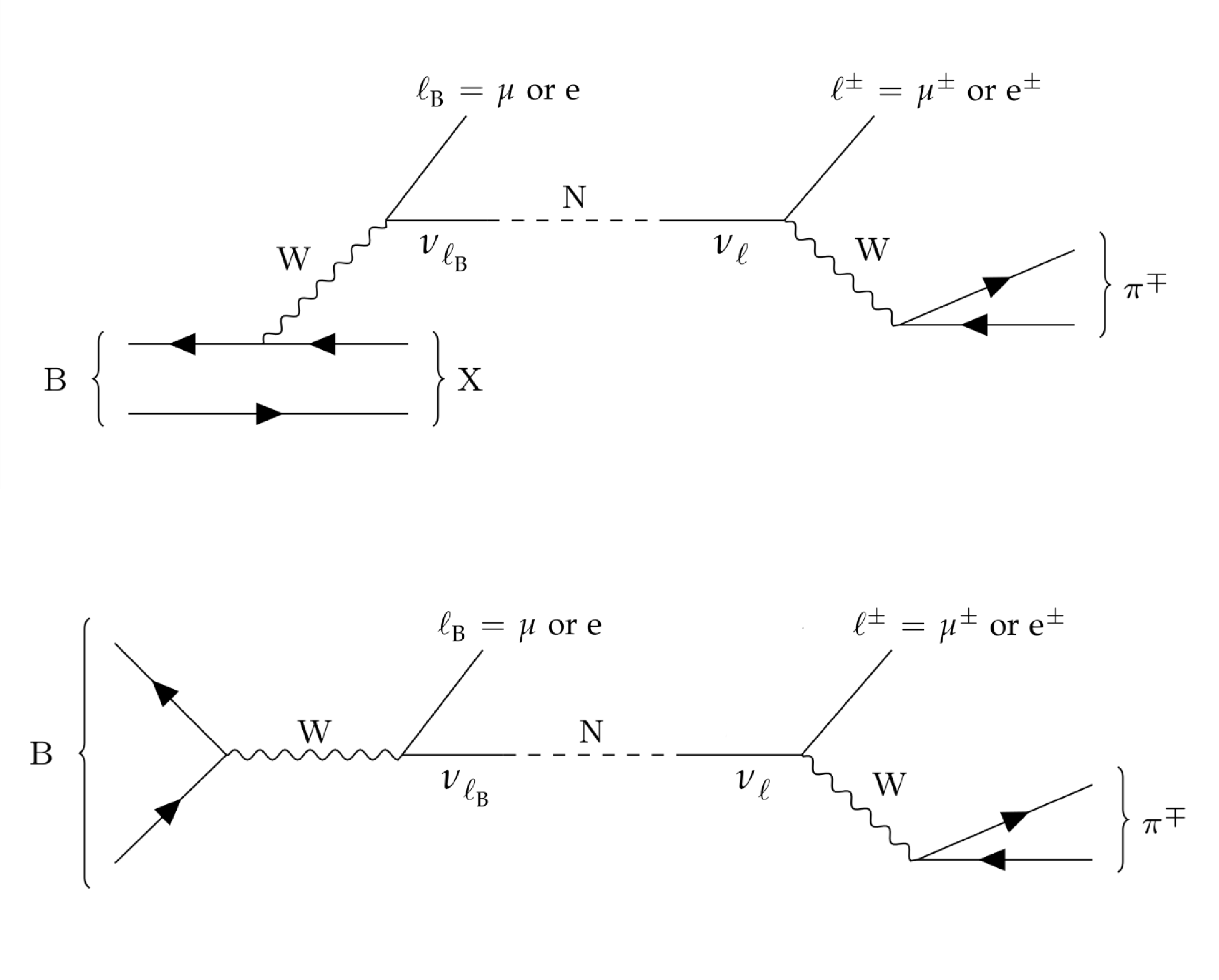
png pdf |
Figure 1:
Feynman diagrams showing the semileptonic (upper row) and leptonic (lower row) decay of a B meson into a lepton ($ \ell_{\mathrm{B}} $), a hadronic system (X) in case of the semileptonic decay, and a neutrino ($ \nu_{\ell_{\mathrm{B}}} $), which contains a small admixture of a heavy neutrino (N). The N mass eigenstate propagates and, according to its admixture of the neutrino flavour eigenstate ($ \nu_{\ell} $), decays weakly into a lepton $ \ell^{\pm} $ and a charged pion $ \pi^{\mp} $. |

png pdf |
Figure 1-a:
Feynman diagrams showing the semileptonic (upper row) and leptonic (lower row) decay of a B meson into a lepton ($ \ell_{\mathrm{B}} $), a hadronic system (X) in case of the semileptonic decay, and a neutrino ($ \nu_{\ell_{\mathrm{B}}} $), which contains a small admixture of a heavy neutrino (N). The N mass eigenstate propagates and, according to its admixture of the neutrino flavour eigenstate ($ \nu_{\ell} $), decays weakly into a lepton $ \ell^{\pm} $ and a charged pion $ \pi^{\mp} $. |

png pdf |
Figure 1-b:
Feynman diagrams showing the semileptonic (upper row) and leptonic (lower row) decay of a B meson into a lepton ($ \ell_{\mathrm{B}} $), a hadronic system (X) in case of the semileptonic decay, and a neutrino ($ \nu_{\ell_{\mathrm{B}}} $), which contains a small admixture of a heavy neutrino (N). The N mass eigenstate propagates and, according to its admixture of the neutrino flavour eigenstate ($ \nu_{\ell} $), decays weakly into a lepton $ \ell^{\pm} $ and a charged pion $ \pi^{\mp} $. |
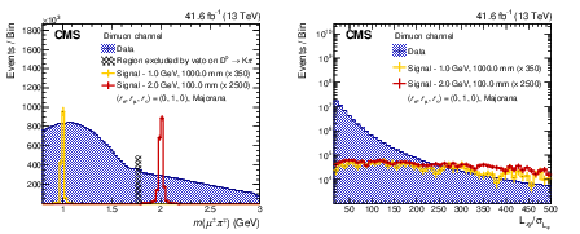
png pdf |
Figure 2:
Distribution of the displaced $ \mu^{\pm}\pi^{\mp} $ invariant mass (left) and $ L_{xy}/\sigma_{L_{xy}} $ (right) in data and in simulated event samples corresponding to two different signal hypotheses, in the Majorana scenario, and with the N mixing exclusively with the muon sector: $ m_\mathrm{N} = $ 1 GeV, $ c\tau_{\mathrm{N}} =$ 1000 mm, $ |V_\mathrm{N}|^2= |V_{\mu\mathrm{N}}|^2 = $ 5.4 $\times$ 10$^{-4} $; and $ m_\mathrm{N} = $ 2 GeV, $ c\tau_{\mathrm{N}} = $ 100 mm, $ |V_\mathrm{N}|^2=|V_{\mu\mathrm{N}}|^2=$ 1.7 $\times$ 10$^{-4} $. The signal distributions are scaled with factors given in the legend. The vertical lines show the statistical uncertainty in each bin. |
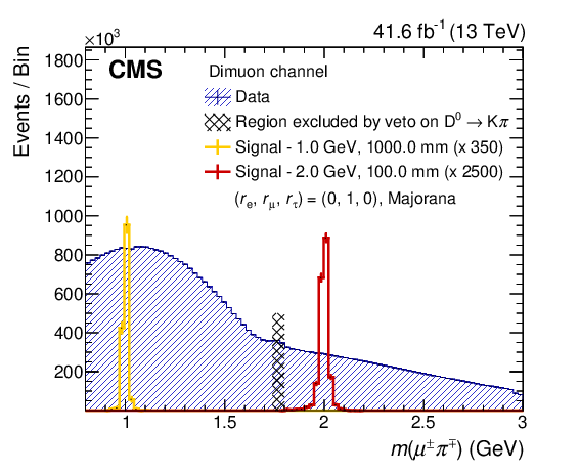
png pdf |
Figure 2-a:
Distribution of the displaced $ \mu^{\pm}\pi^{\mp} $ invariant mass (left) and $ L_{xy}/\sigma_{L_{xy}} $ (right) in data and in simulated event samples corresponding to two different signal hypotheses, in the Majorana scenario, and with the N mixing exclusively with the muon sector: $ m_\mathrm{N} = $ 1 GeV, $ c\tau_{\mathrm{N}} =$ 1000 mm, $ |V_\mathrm{N}|^2= |V_{\mu\mathrm{N}}|^2 = $ 5.4 $\times$ 10$^{-4} $; and $ m_\mathrm{N} = $ 2 GeV, $ c\tau_{\mathrm{N}} = $ 100 mm, $ |V_\mathrm{N}|^2=|V_{\mu\mathrm{N}}|^2=$ 1.7 $\times$ 10$^{-4} $. The signal distributions are scaled with factors given in the legend. The vertical lines show the statistical uncertainty in each bin. |
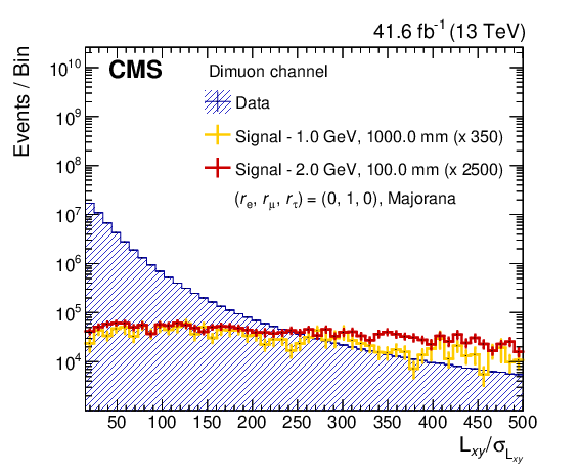
png pdf |
Figure 2-b:
Distribution of the displaced $ \mu^{\pm}\pi^{\mp} $ invariant mass (left) and $ L_{xy}/\sigma_{L_{xy}} $ (right) in data and in simulated event samples corresponding to two different signal hypotheses, in the Majorana scenario, and with the N mixing exclusively with the muon sector: $ m_\mathrm{N} = $ 1 GeV, $ c\tau_{\mathrm{N}} =$ 1000 mm, $ |V_\mathrm{N}|^2= |V_{\mu\mathrm{N}}|^2 = $ 5.4 $\times$ 10$^{-4} $; and $ m_\mathrm{N} = $ 2 GeV, $ c\tau_{\mathrm{N}} = $ 100 mm, $ |V_\mathrm{N}|^2=|V_{\mu\mathrm{N}}|^2=$ 1.7 $\times$ 10$^{-4} $. The signal distributions are scaled with factors given in the legend. The vertical lines show the statistical uncertainty in each bin. |
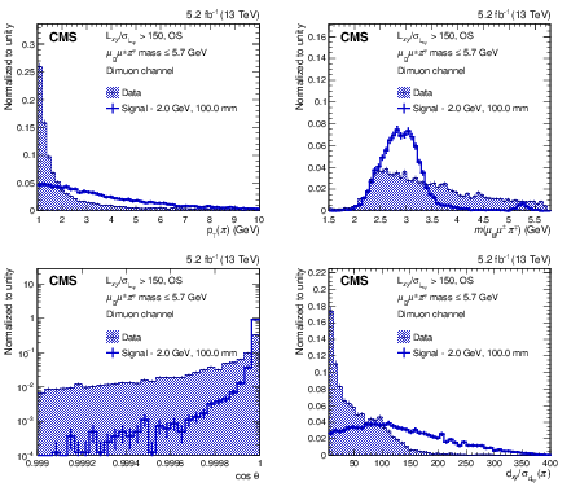
png pdf |
Figure 3:
The distributions of the pion $ p_{\mathrm{T}} $ (upper left), $ m(\mu_{\mathrm{B}}\mu^\pm\pi^\mp) $ (upper right), $ \cos\theta $ (lower left), and pion $ d_{xy}/\sigma_{d_{xy}} $ (lower right) are shown for data, as well as for a signal hypothesis of $ m_\mathrm{N}= $ 2 GeV and $ c\tau_{\mathrm{N}}=$ 100 mm. The data correspond to an integrated luminosity of 5.2 fb$ ^{-1} $ and are selected in the mass window of size 10 $ \sigma $ around $ m_\mathrm{N}= $ 2 GeV. The distributions, which are normalized to unit area, are shown for the dimuon channel in category with high $ L_{xy}/\sigma_{L_{xy}} $, OS, and low $ \ell_{\mathrm{B}}\ell^\pm\pi^\mp\mathrm{ mass} $. The vertical lines show the statistical uncertainty in each bin. |
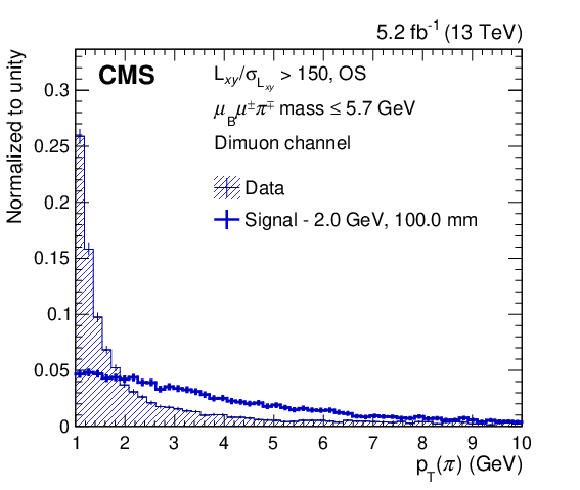
png pdf |
Figure 3-a:
The distributions of the pion $ p_{\mathrm{T}} $ (upper left), $ m(\mu_{\mathrm{B}}\mu^\pm\pi^\mp) $ (upper right), $ \cos\theta $ (lower left), and pion $ d_{xy}/\sigma_{d_{xy}} $ (lower right) are shown for data, as well as for a signal hypothesis of $ m_\mathrm{N}= $ 2 GeV and $ c\tau_{\mathrm{N}}=$ 100 mm. The data correspond to an integrated luminosity of 5.2 fb$ ^{-1} $ and are selected in the mass window of size 10 $ \sigma $ around $ m_\mathrm{N}= $ 2 GeV. The distributions, which are normalized to unit area, are shown for the dimuon channel in category with high $ L_{xy}/\sigma_{L_{xy}} $, OS, and low $ \ell_{\mathrm{B}}\ell^\pm\pi^\mp\mathrm{ mass} $. The vertical lines show the statistical uncertainty in each bin. |

png pdf |
Figure 3-b:
The distributions of the pion $ p_{\mathrm{T}} $ (upper left), $ m(\mu_{\mathrm{B}}\mu^\pm\pi^\mp) $ (upper right), $ \cos\theta $ (lower left), and pion $ d_{xy}/\sigma_{d_{xy}} $ (lower right) are shown for data, as well as for a signal hypothesis of $ m_\mathrm{N}= $ 2 GeV and $ c\tau_{\mathrm{N}}=$ 100 mm. The data correspond to an integrated luminosity of 5.2 fb$ ^{-1} $ and are selected in the mass window of size 10 $ \sigma $ around $ m_\mathrm{N}= $ 2 GeV. The distributions, which are normalized to unit area, are shown for the dimuon channel in category with high $ L_{xy}/\sigma_{L_{xy}} $, OS, and low $ \ell_{\mathrm{B}}\ell^\pm\pi^\mp\mathrm{ mass} $. The vertical lines show the statistical uncertainty in each bin. |

png pdf |
Figure 3-c:
The distributions of the pion $ p_{\mathrm{T}} $ (upper left), $ m(\mu_{\mathrm{B}}\mu^\pm\pi^\mp) $ (upper right), $ \cos\theta $ (lower left), and pion $ d_{xy}/\sigma_{d_{xy}} $ (lower right) are shown for data, as well as for a signal hypothesis of $ m_\mathrm{N}= $ 2 GeV and $ c\tau_{\mathrm{N}}=$ 100 mm. The data correspond to an integrated luminosity of 5.2 fb$ ^{-1} $ and are selected in the mass window of size 10 $ \sigma $ around $ m_\mathrm{N}= $ 2 GeV. The distributions, which are normalized to unit area, are shown for the dimuon channel in category with high $ L_{xy}/\sigma_{L_{xy}} $, OS, and low $ \ell_{\mathrm{B}}\ell^\pm\pi^\mp\mathrm{ mass} $. The vertical lines show the statistical uncertainty in each bin. |

png pdf |
Figure 3-d:
The distributions of the pion $ p_{\mathrm{T}} $ (upper left), $ m(\mu_{\mathrm{B}}\mu^\pm\pi^\mp) $ (upper right), $ \cos\theta $ (lower left), and pion $ d_{xy}/\sigma_{d_{xy}} $ (lower right) are shown for data, as well as for a signal hypothesis of $ m_\mathrm{N}= $ 2 GeV and $ c\tau_{\mathrm{N}}=$ 100 mm. The data correspond to an integrated luminosity of 5.2 fb$ ^{-1} $ and are selected in the mass window of size 10 $ \sigma $ around $ m_\mathrm{N}= $ 2 GeV. The distributions, which are normalized to unit area, are shown for the dimuon channel in category with high $ L_{xy}/\sigma_{L_{xy}} $, OS, and low $ \ell_{\mathrm{B}}\ell^\pm\pi^\mp\mathrm{ mass} $. The vertical lines show the statistical uncertainty in each bin. |
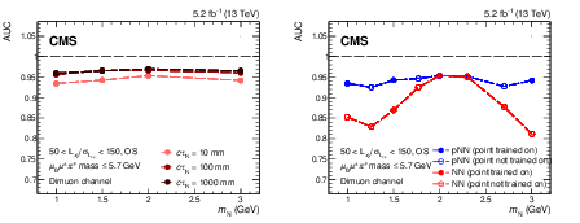
png pdf |
Figure 4:
(Left) Performance of the pNN as a function of signal mass for events in the 50 $ < L_{xy}/\sigma_{L_{xy}} < $ 150, OS, and low $ \ell_{\mathrm{B}}\ell^\pm\pi^\mp\mathrm{ mass} $ category in the dimuon channel. The performance is shown by the AUC curve, where a value at unity corresponds to a perfect separation between signal and background. The different coloured curves correspond to different $ c\tau_{\mathrm{N}} $ hypotheses. (Right) Validation of the use of a pNN for intermediate $ m_\mathrm{N} $ mass points, for events in the 50 $ < L_{xy}/\sigma_{L_{xy}} < $ 150, OS and low $ \ell_{\mathrm{B}}\ell^\pm\pi^\mp\mathrm{ mass} $ category in the dimuon channel: a pNN trained on masses $ m_\mathrm{N} = $ 1.0, 1.5, 2.0, and 3.0 GeV (blue) and a NN trained on mass $ m_\mathrm{N}= $ 2 GeV (red). All the points have $ c\tau_{\mathrm{N}}=$ 10 mm. The full circles correspond to mass points on which the pNN and NN were trained on, while the open circles show mass points that have not been trained on. |
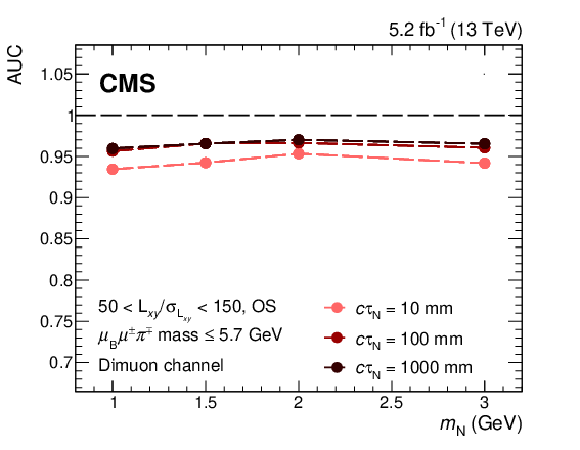
png pdf |
Figure 4-a:
(Left) Performance of the pNN as a function of signal mass for events in the 50 $ < L_{xy}/\sigma_{L_{xy}} < $ 150, OS, and low $ \ell_{\mathrm{B}}\ell^\pm\pi^\mp\mathrm{ mass} $ category in the dimuon channel. The performance is shown by the AUC curve, where a value at unity corresponds to a perfect separation between signal and background. The different coloured curves correspond to different $ c\tau_{\mathrm{N}} $ hypotheses. (Right) Validation of the use of a pNN for intermediate $ m_\mathrm{N} $ mass points, for events in the 50 $ < L_{xy}/\sigma_{L_{xy}} < $ 150, OS and low $ \ell_{\mathrm{B}}\ell^\pm\pi^\mp\mathrm{ mass} $ category in the dimuon channel: a pNN trained on masses $ m_\mathrm{N} = $ 1.0, 1.5, 2.0, and 3.0 GeV (blue) and a NN trained on mass $ m_\mathrm{N}= $ 2 GeV (red). All the points have $ c\tau_{\mathrm{N}}=$ 10 mm. The full circles correspond to mass points on which the pNN and NN were trained on, while the open circles show mass points that have not been trained on. |
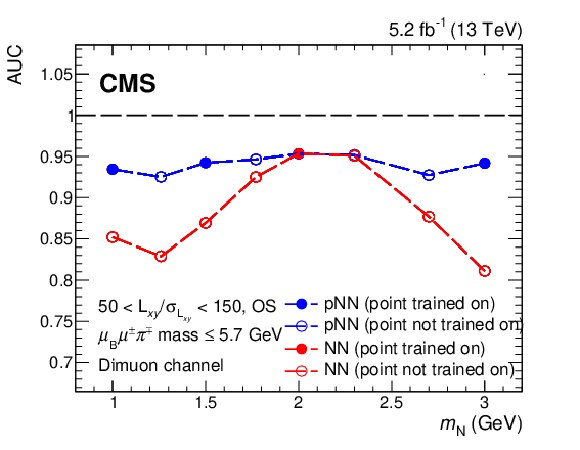
png pdf |
Figure 4-b:
(Left) Performance of the pNN as a function of signal mass for events in the 50 $ < L_{xy}/\sigma_{L_{xy}} < $ 150, OS, and low $ \ell_{\mathrm{B}}\ell^\pm\pi^\mp\mathrm{ mass} $ category in the dimuon channel. The performance is shown by the AUC curve, where a value at unity corresponds to a perfect separation between signal and background. The different coloured curves correspond to different $ c\tau_{\mathrm{N}} $ hypotheses. (Right) Validation of the use of a pNN for intermediate $ m_\mathrm{N} $ mass points, for events in the 50 $ < L_{xy}/\sigma_{L_{xy}} < $ 150, OS and low $ \ell_{\mathrm{B}}\ell^\pm\pi^\mp\mathrm{ mass} $ category in the dimuon channel: a pNN trained on masses $ m_\mathrm{N} = $ 1.0, 1.5, 2.0, and 3.0 GeV (blue) and a NN trained on mass $ m_\mathrm{N}= $ 2 GeV (red). All the points have $ c\tau_{\mathrm{N}}=$ 10 mm. The full circles correspond to mass points on which the pNN and NN were trained on, while the open circles show mass points that have not been trained on. |
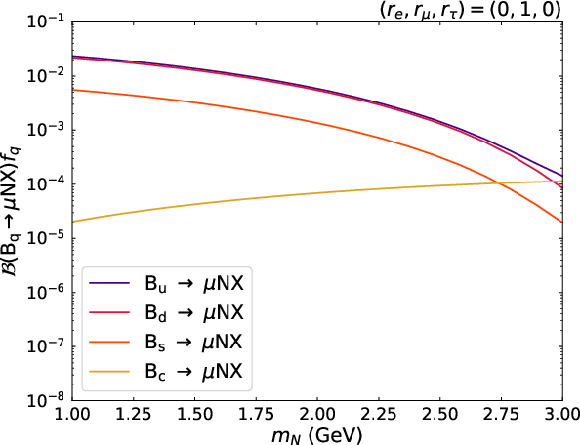
png pdf |
Figure 5:
Branching fractions as functions of $ m_\mathrm{N} $ for $ {\mathrm{B}}_\mathrm{q}\to\mu\mathrm{N}\mathrm{X} $ decays, $ \mathrm{q} = (\mathrm{u}, \mathrm{d}, \mathrm{s}, \mathrm{c}) $, multiplied by the corresponding fragmentation fraction, $ f_{\mathrm{q}} $. Both leptonic and semileptonic decays are considered. The results are shown for the mixing scenario $ |V_\mathrm{N}|^2=|V_{\mu\mathrm{N}}|^2= $ 1. The branching fractions are computed based on the method described in Ref. [10]. |
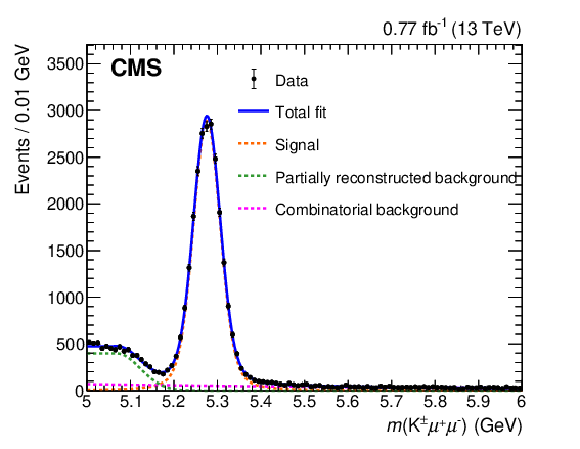
png pdf |
Figure 6:
Distribution of the $ \mathrm{K}^\pm\mu^+\mu^- $ invariant mass for a luminosity of 0.77 fb$ ^{-1} $. A large signal is observed at the $ {\mathrm{B}}_{\mathrm{u}} $ mass. The blue curve shows the fit to signal plus background, while the orange, green, and red curves show the contributions from the signal, composite background, and combinatorial background, respectively. |
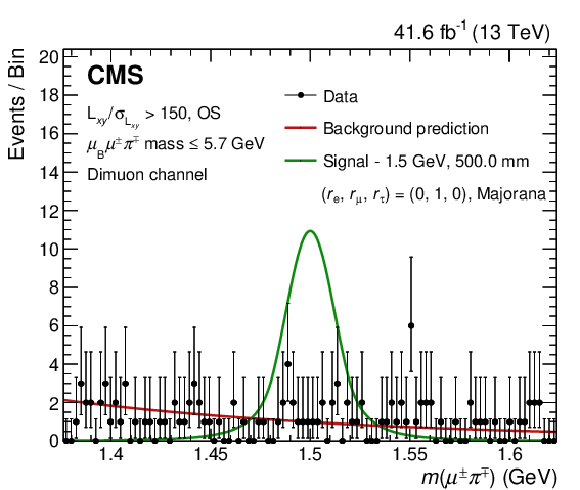
png pdf |
Figure 7:
Distribution of the $ \mu^\pm\pi^\mp $ invariant mass in the mass window around 1.5 GeV in the high $ L_{xy}/\sigma_{L_{xy}} $, OS, and low $ \ell_{\mathrm{B}}\ell^\pm\pi^\mp\mathrm{ mass} $ category in the dimuon channel. The result of the background-only fit to the data (red) is shown together with the mass distribution expected from a Majorana signal with $ m_\mathrm{N}= $ 1.5 GeV and $ c\tau_{\mathrm{N}}=$ 500 mm, for the case in which the N mixes with the muon sector only (green). |
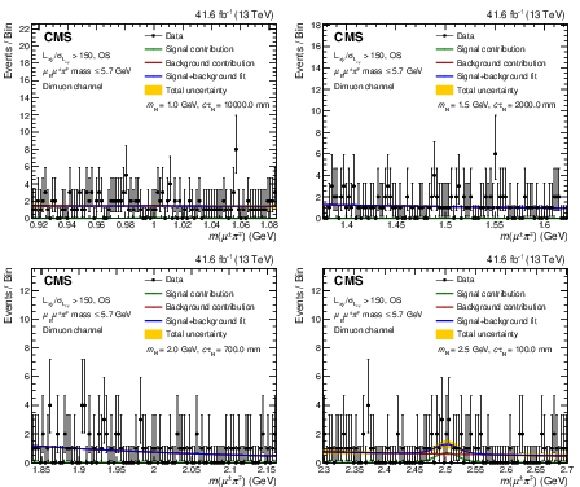
png pdf |
Figure 8:
Fits of the mass distribution for a signal of mass $ m_\mathrm{N}= $ 1.0 GeV (upper left), 1.5 GeV (upper right), 2.0 GeV (lower left), and 2.5 GeV (lower right), in the high $ L_{xy}/\sigma_{L_{xy}} $, OS, and low $ \ell_{\mathrm{B}}\ell^\pm\pi^\mp\mathrm{ mass} $ category of the dimuon channel. The blue curve corresponds to signal-plus-background fit, while the green and red curves indicate its individual signal and background components, respectively. The yellow band shows the total post-fit systematic plus statistical uncertainty. |

png pdf |
Figure 8-a:
Fits of the mass distribution for a signal of mass $ m_\mathrm{N}= $ 1.0 GeV (upper left), 1.5 GeV (upper right), 2.0 GeV (lower left), and 2.5 GeV (lower right), in the high $ L_{xy}/\sigma_{L_{xy}} $, OS, and low $ \ell_{\mathrm{B}}\ell^\pm\pi^\mp\mathrm{ mass} $ category of the dimuon channel. The blue curve corresponds to signal-plus-background fit, while the green and red curves indicate its individual signal and background components, respectively. The yellow band shows the total post-fit systematic plus statistical uncertainty. |
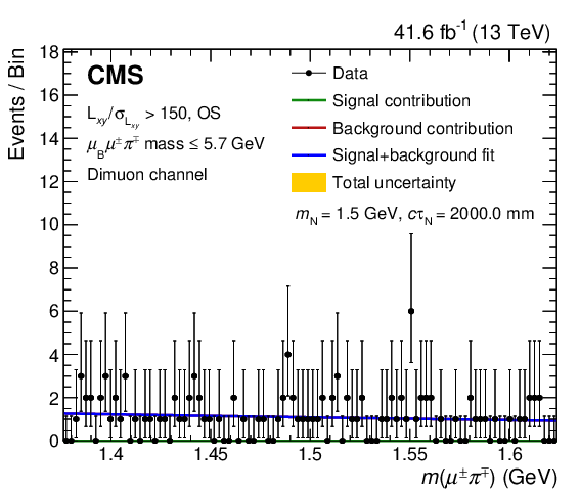
png pdf |
Figure 8-b:
Fits of the mass distribution for a signal of mass $ m_\mathrm{N}= $ 1.0 GeV (upper left), 1.5 GeV (upper right), 2.0 GeV (lower left), and 2.5 GeV (lower right), in the high $ L_{xy}/\sigma_{L_{xy}} $, OS, and low $ \ell_{\mathrm{B}}\ell^\pm\pi^\mp\mathrm{ mass} $ category of the dimuon channel. The blue curve corresponds to signal-plus-background fit, while the green and red curves indicate its individual signal and background components, respectively. The yellow band shows the total post-fit systematic plus statistical uncertainty. |
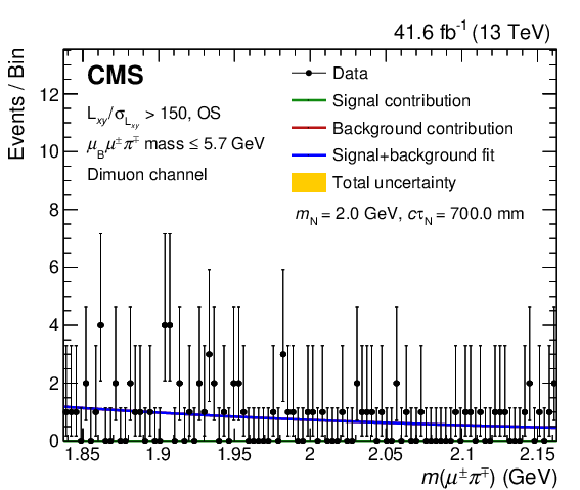
png pdf |
Figure 8-c:
Fits of the mass distribution for a signal of mass $ m_\mathrm{N}= $ 1.0 GeV (upper left), 1.5 GeV (upper right), 2.0 GeV (lower left), and 2.5 GeV (lower right), in the high $ L_{xy}/\sigma_{L_{xy}} $, OS, and low $ \ell_{\mathrm{B}}\ell^\pm\pi^\mp\mathrm{ mass} $ category of the dimuon channel. The blue curve corresponds to signal-plus-background fit, while the green and red curves indicate its individual signal and background components, respectively. The yellow band shows the total post-fit systematic plus statistical uncertainty. |
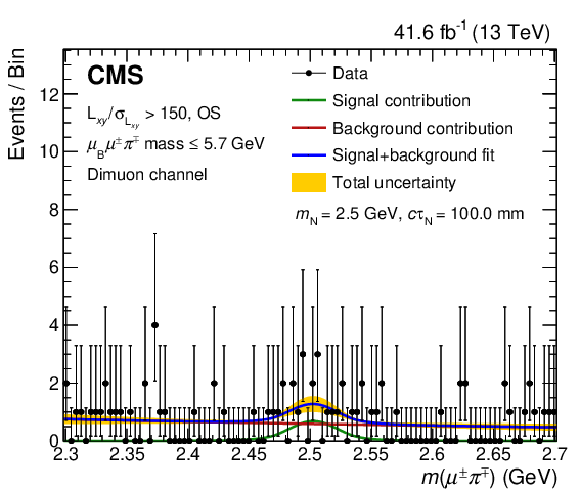
png pdf |
Figure 8-d:
Fits of the mass distribution for a signal of mass $ m_\mathrm{N}= $ 1.0 GeV (upper left), 1.5 GeV (upper right), 2.0 GeV (lower left), and 2.5 GeV (lower right), in the high $ L_{xy}/\sigma_{L_{xy}} $, OS, and low $ \ell_{\mathrm{B}}\ell^\pm\pi^\mp\mathrm{ mass} $ category of the dimuon channel. The blue curve corresponds to signal-plus-background fit, while the green and red curves indicate its individual signal and background components, respectively. The yellow band shows the total post-fit systematic plus statistical uncertainty. |
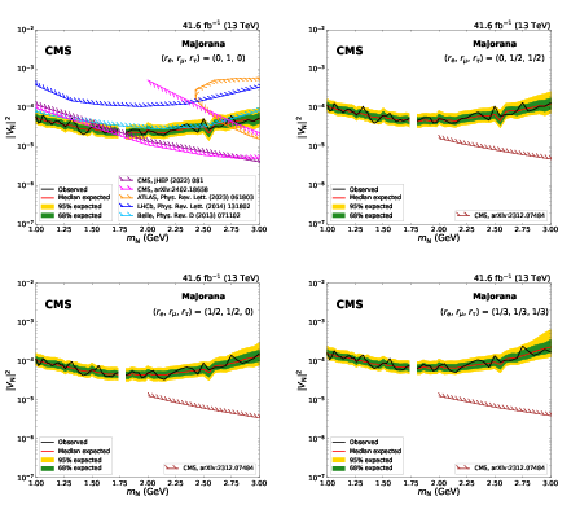
png pdf |
Figure 9:
Expected and observed 95% CL limits on $ |V_\mathrm{N}|^2 $ as a function of $ m_\mathrm{N} $, in the Majorana scenario. On the upper row, the limits are derived uniquely with the dimuon channel, and are shown for the mixing scenarios ($ r_\mathrm{e} $, $ r_\mu $, $ r_\tau $) $= $(0, 1, 0) on the left and for ($ r_\mathrm{e} $, $ r_\mu $, $ r_\tau $) $=$ (0, 1/2, 1/2) on the right; on the lower row, the limits are obtained with the dimuon and mixed-flavour channel combined, for the mixing scenarios ($ r_\mathrm{e} $, $ r_\mu $, $ r_\tau $) $=$ (1/2, 1/2, 0) on the left and for ($ r_\mathrm{e} $, $ r_\mu $, $ r_\tau $) $=$ (1/3, 1/3, 1/3) on the right. n the upper left figure, results from the CMS [22,24], ATLAS [18], LHCb [25], and Belle [15] Collaborations are shown as a comparison; in the other figures, results from the CMS Collaboration [23] are reported. The mass range with no results shown corresponds to the $ \mathrm{D^0} $ meson veto listed in the lower part of Table 1. |
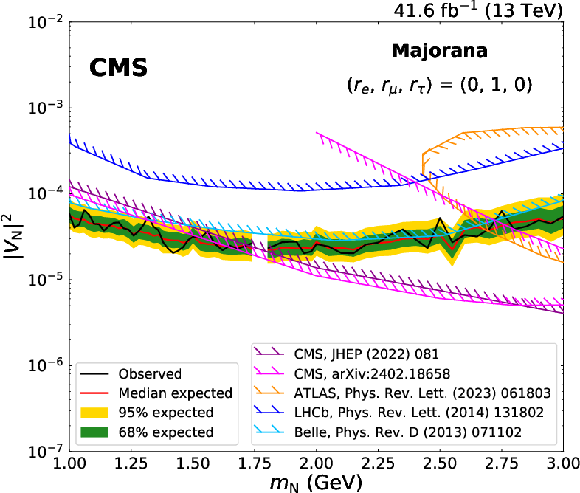
png pdf |
Figure 9-a:
Expected and observed 95% CL limits on $ |V_\mathrm{N}|^2 $ as a function of $ m_\mathrm{N} $, in the Majorana scenario. On the upper row, the limits are derived uniquely with the dimuon channel, and are shown for the mixing scenarios ($ r_\mathrm{e} $, $ r_\mu $, $ r_\tau $) $= $(0, 1, 0) on the left and for ($ r_\mathrm{e} $, $ r_\mu $, $ r_\tau $) $=$ (0, 1/2, 1/2) on the right; on the lower row, the limits are obtained with the dimuon and mixed-flavour channel combined, for the mixing scenarios ($ r_\mathrm{e} $, $ r_\mu $, $ r_\tau $) $=$ (1/2, 1/2, 0) on the left and for ($ r_\mathrm{e} $, $ r_\mu $, $ r_\tau $) $=$ (1/3, 1/3, 1/3) on the right. n the upper left figure, results from the CMS [22,24], ATLAS [18], LHCb [25], and Belle [15] Collaborations are shown as a comparison; in the other figures, results from the CMS Collaboration [23] are reported. The mass range with no results shown corresponds to the $ \mathrm{D^0} $ meson veto listed in the lower part of Table 1. |
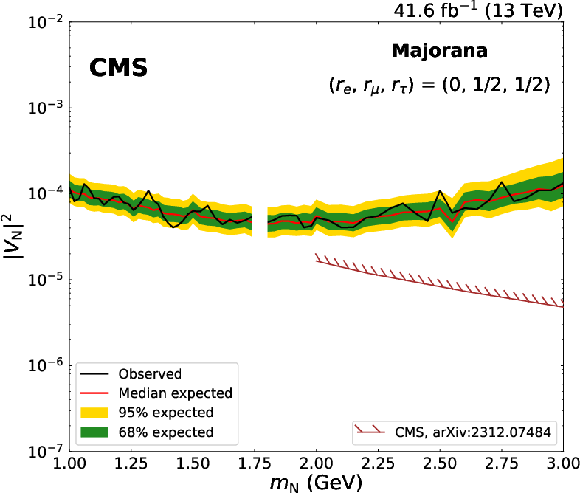
png pdf |
Figure 9-b:
Expected and observed 95% CL limits on $ |V_\mathrm{N}|^2 $ as a function of $ m_\mathrm{N} $, in the Majorana scenario. On the upper row, the limits are derived uniquely with the dimuon channel, and are shown for the mixing scenarios ($ r_\mathrm{e} $, $ r_\mu $, $ r_\tau $) $= $(0, 1, 0) on the left and for ($ r_\mathrm{e} $, $ r_\mu $, $ r_\tau $) $=$ (0, 1/2, 1/2) on the right; on the lower row, the limits are obtained with the dimuon and mixed-flavour channel combined, for the mixing scenarios ($ r_\mathrm{e} $, $ r_\mu $, $ r_\tau $) $=$ (1/2, 1/2, 0) on the left and for ($ r_\mathrm{e} $, $ r_\mu $, $ r_\tau $) $=$ (1/3, 1/3, 1/3) on the right. n the upper left figure, results from the CMS [22,24], ATLAS [18], LHCb [25], and Belle [15] Collaborations are shown as a comparison; in the other figures, results from the CMS Collaboration [23] are reported. The mass range with no results shown corresponds to the $ \mathrm{D^0} $ meson veto listed in the lower part of Table 1. |

png pdf |
Figure 9-c:
Expected and observed 95% CL limits on $ |V_\mathrm{N}|^2 $ as a function of $ m_\mathrm{N} $, in the Majorana scenario. On the upper row, the limits are derived uniquely with the dimuon channel, and are shown for the mixing scenarios ($ r_\mathrm{e} $, $ r_\mu $, $ r_\tau $) $= $(0, 1, 0) on the left and for ($ r_\mathrm{e} $, $ r_\mu $, $ r_\tau $) $=$ (0, 1/2, 1/2) on the right; on the lower row, the limits are obtained with the dimuon and mixed-flavour channel combined, for the mixing scenarios ($ r_\mathrm{e} $, $ r_\mu $, $ r_\tau $) $=$ (1/2, 1/2, 0) on the left and for ($ r_\mathrm{e} $, $ r_\mu $, $ r_\tau $) $=$ (1/3, 1/3, 1/3) on the right. n the upper left figure, results from the CMS [22,24], ATLAS [18], LHCb [25], and Belle [15] Collaborations are shown as a comparison; in the other figures, results from the CMS Collaboration [23] are reported. The mass range with no results shown corresponds to the $ \mathrm{D^0} $ meson veto listed in the lower part of Table 1. |
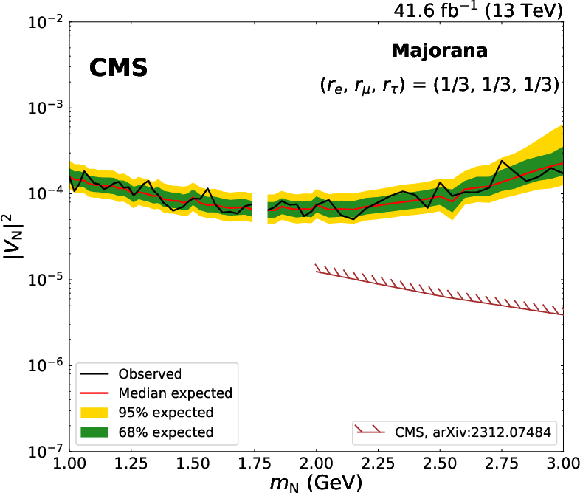
png pdf |
Figure 9-d:
Expected and observed 95% CL limits on $ |V_\mathrm{N}|^2 $ as a function of $ m_\mathrm{N} $, in the Majorana scenario. On the upper row, the limits are derived uniquely with the dimuon channel, and are shown for the mixing scenarios ($ r_\mathrm{e} $, $ r_\mu $, $ r_\tau $) $= $(0, 1, 0) on the left and for ($ r_\mathrm{e} $, $ r_\mu $, $ r_\tau $) $=$ (0, 1/2, 1/2) on the right; on the lower row, the limits are obtained with the dimuon and mixed-flavour channel combined, for the mixing scenarios ($ r_\mathrm{e} $, $ r_\mu $, $ r_\tau $) $=$ (1/2, 1/2, 0) on the left and for ($ r_\mathrm{e} $, $ r_\mu $, $ r_\tau $) $=$ (1/3, 1/3, 1/3) on the right. n the upper left figure, results from the CMS [22,24], ATLAS [18], LHCb [25], and Belle [15] Collaborations are shown as a comparison; in the other figures, results from the CMS Collaboration [23] are reported. The mass range with no results shown corresponds to the $ \mathrm{D^0} $ meson veto listed in the lower part of Table 1. |
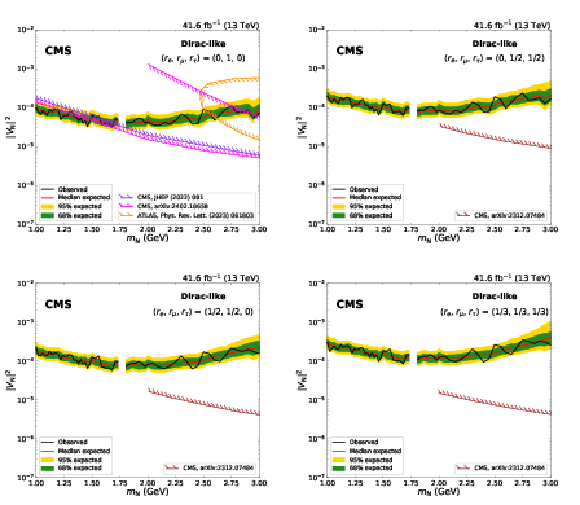
png pdf |
Figure 10:
Expected and observed 95% CL limits on $ |V_\mathrm{N}|^2 $ as a function of $ m_\mathrm{N} $, in the Dirac-like scenario. On the upper row, the limits are derived uniquely with the dimuon channel, and are shown for the mixing scenarios ($ r_\mathrm{e} $, $ r_\mu $, $ r_\tau $) $=$ (0, 1, 0) on the left and for ($ r_\mathrm{e} $, $ r_\mu $, $ r_\tau $) = (0, 1/2, 1/2) on the right; on the lower row, the limits are obtained with the dimuon and mixed-flavour channel combined, for the mixing scenarios ($ r_\mathrm{e} $, $ r_\mu $, $ r_\tau $) $=$ (1/2, 1/2, 0) on the left and for ($ r_\mathrm{e} $, $ r_\mu $, $ r_\tau $) $=$ (1/3, 1/3, 1/3) on the right. In the upper left figure, results from the CMS [22,24] and ATLAS [18] Collaborations are shown as a comparison; in the other figures, results from the CMS Collaboration [23] are reported. The mass range with no results shown corresponds to the $ \mathrm{D^0} $ meson veto listed in the lower part of Table 1. |

png pdf |
Figure 10-a:
Expected and observed 95% CL limits on $ |V_\mathrm{N}|^2 $ as a function of $ m_\mathrm{N} $, in the Dirac-like scenario. On the upper row, the limits are derived uniquely with the dimuon channel, and are shown for the mixing scenarios ($ r_\mathrm{e} $, $ r_\mu $, $ r_\tau $) $=$ (0, 1, 0) on the left and for ($ r_\mathrm{e} $, $ r_\mu $, $ r_\tau $) = (0, 1/2, 1/2) on the right; on the lower row, the limits are obtained with the dimuon and mixed-flavour channel combined, for the mixing scenarios ($ r_\mathrm{e} $, $ r_\mu $, $ r_\tau $) $=$ (1/2, 1/2, 0) on the left and for ($ r_\mathrm{e} $, $ r_\mu $, $ r_\tau $) $=$ (1/3, 1/3, 1/3) on the right. In the upper left figure, results from the CMS [22,24] and ATLAS [18] Collaborations are shown as a comparison; in the other figures, results from the CMS Collaboration [23] are reported. The mass range with no results shown corresponds to the $ \mathrm{D^0} $ meson veto listed in the lower part of Table 1. |
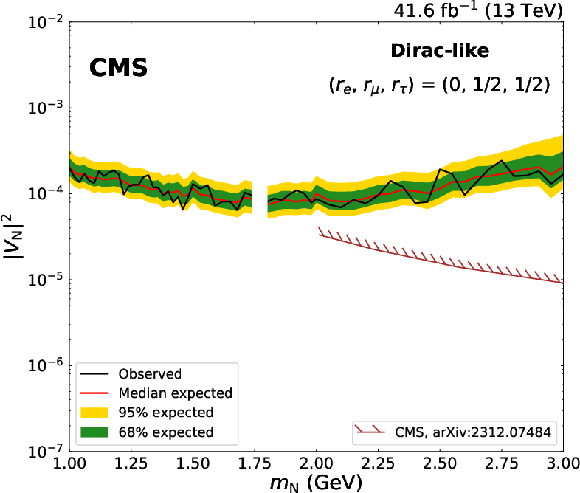
png pdf |
Figure 10-b:
Expected and observed 95% CL limits on $ |V_\mathrm{N}|^2 $ as a function of $ m_\mathrm{N} $, in the Dirac-like scenario. On the upper row, the limits are derived uniquely with the dimuon channel, and are shown for the mixing scenarios ($ r_\mathrm{e} $, $ r_\mu $, $ r_\tau $) $=$ (0, 1, 0) on the left and for ($ r_\mathrm{e} $, $ r_\mu $, $ r_\tau $) = (0, 1/2, 1/2) on the right; on the lower row, the limits are obtained with the dimuon and mixed-flavour channel combined, for the mixing scenarios ($ r_\mathrm{e} $, $ r_\mu $, $ r_\tau $) $=$ (1/2, 1/2, 0) on the left and for ($ r_\mathrm{e} $, $ r_\mu $, $ r_\tau $) $=$ (1/3, 1/3, 1/3) on the right. In the upper left figure, results from the CMS [22,24] and ATLAS [18] Collaborations are shown as a comparison; in the other figures, results from the CMS Collaboration [23] are reported. The mass range with no results shown corresponds to the $ \mathrm{D^0} $ meson veto listed in the lower part of Table 1. |
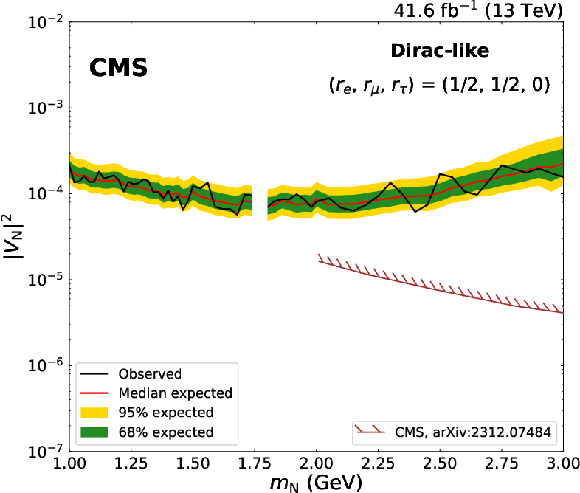
png pdf |
Figure 10-c:
Expected and observed 95% CL limits on $ |V_\mathrm{N}|^2 $ as a function of $ m_\mathrm{N} $, in the Dirac-like scenario. On the upper row, the limits are derived uniquely with the dimuon channel, and are shown for the mixing scenarios ($ r_\mathrm{e} $, $ r_\mu $, $ r_\tau $) $=$ (0, 1, 0) on the left and for ($ r_\mathrm{e} $, $ r_\mu $, $ r_\tau $) = (0, 1/2, 1/2) on the right; on the lower row, the limits are obtained with the dimuon and mixed-flavour channel combined, for the mixing scenarios ($ r_\mathrm{e} $, $ r_\mu $, $ r_\tau $) $=$ (1/2, 1/2, 0) on the left and for ($ r_\mathrm{e} $, $ r_\mu $, $ r_\tau $) $=$ (1/3, 1/3, 1/3) on the right. In the upper left figure, results from the CMS [22,24] and ATLAS [18] Collaborations are shown as a comparison; in the other figures, results from the CMS Collaboration [23] are reported. The mass range with no results shown corresponds to the $ \mathrm{D^0} $ meson veto listed in the lower part of Table 1. |

png pdf |
Figure 10-d:
Expected and observed 95% CL limits on $ |V_\mathrm{N}|^2 $ as a function of $ m_\mathrm{N} $, in the Dirac-like scenario. On the upper row, the limits are derived uniquely with the dimuon channel, and are shown for the mixing scenarios ($ r_\mathrm{e} $, $ r_\mu $, $ r_\tau $) $=$ (0, 1, 0) on the left and for ($ r_\mathrm{e} $, $ r_\mu $, $ r_\tau $) = (0, 1/2, 1/2) on the right; on the lower row, the limits are obtained with the dimuon and mixed-flavour channel combined, for the mixing scenarios ($ r_\mathrm{e} $, $ r_\mu $, $ r_\tau $) $=$ (1/2, 1/2, 0) on the left and for ($ r_\mathrm{e} $, $ r_\mu $, $ r_\tau $) $=$ (1/3, 1/3, 1/3) on the right. In the upper left figure, results from the CMS [22,24] and ATLAS [18] Collaborations are shown as a comparison; in the other figures, results from the CMS Collaboration [23] are reported. The mass range with no results shown corresponds to the $ \mathrm{D^0} $ meson veto listed in the lower part of Table 1. |
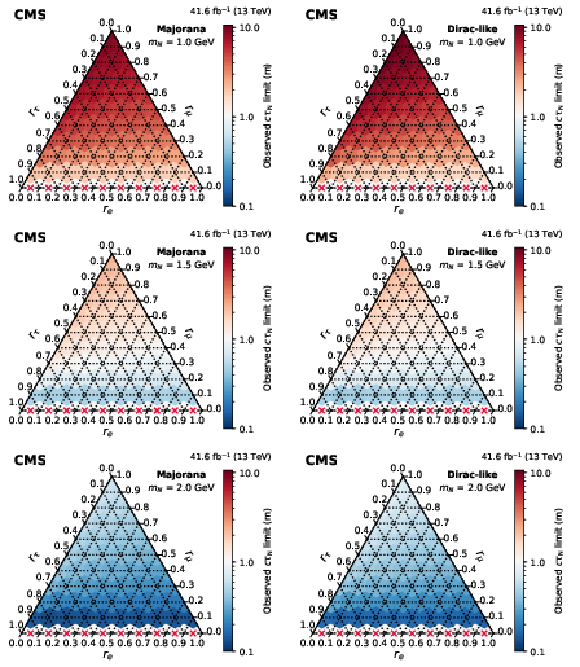
png pdf |
Figure 11:
Observed 95% CL lower limits on $ c\tau_{\mathrm{N}} $ as functions of the mixing ratios ($ r_\mathrm{e} $, $ r_\mu $, $ r_\tau $) for fixed N masses of 1 GeV (upper row), 1.5 GeV (middle row), and 2 GeV (lower row), in the Majorana (left column) and Dirac-like (right column) scenarios. The red crosses indicate that there is no exclusion found for that point. The orientation of the value markers on each axis identifies the associated internal lines on the plot. |

png pdf |
Figure 11-a:
Observed 95% CL lower limits on $ c\tau_{\mathrm{N}} $ as functions of the mixing ratios ($ r_\mathrm{e} $, $ r_\mu $, $ r_\tau $) for fixed N masses of 1 GeV (upper row), 1.5 GeV (middle row), and 2 GeV (lower row), in the Majorana (left column) and Dirac-like (right column) scenarios. The red crosses indicate that there is no exclusion found for that point. The orientation of the value markers on each axis identifies the associated internal lines on the plot. |
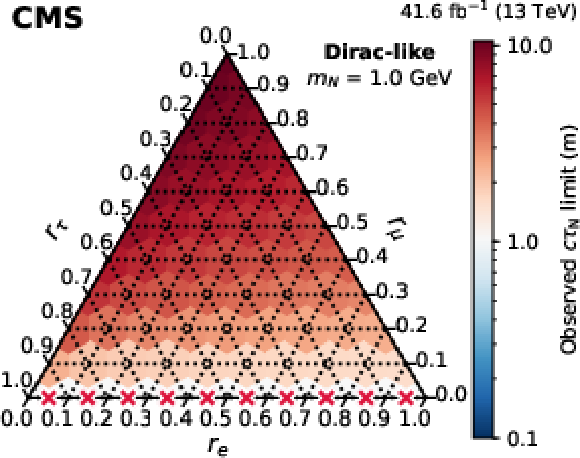
png pdf |
Figure 11-b:
Observed 95% CL lower limits on $ c\tau_{\mathrm{N}} $ as functions of the mixing ratios ($ r_\mathrm{e} $, $ r_\mu $, $ r_\tau $) for fixed N masses of 1 GeV (upper row), 1.5 GeV (middle row), and 2 GeV (lower row), in the Majorana (left column) and Dirac-like (right column) scenarios. The red crosses indicate that there is no exclusion found for that point. The orientation of the value markers on each axis identifies the associated internal lines on the plot. |
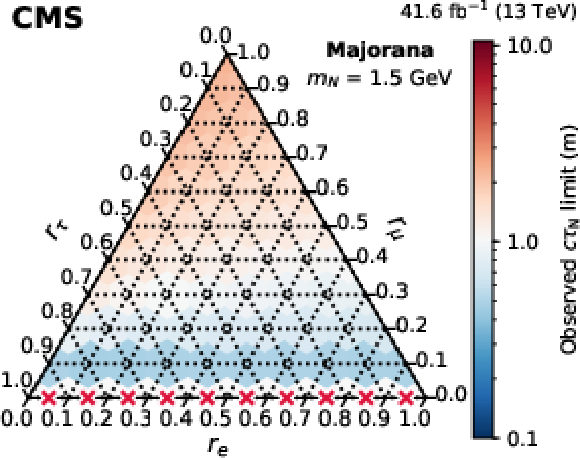
png pdf |
Figure 11-c:
Observed 95% CL lower limits on $ c\tau_{\mathrm{N}} $ as functions of the mixing ratios ($ r_\mathrm{e} $, $ r_\mu $, $ r_\tau $) for fixed N masses of 1 GeV (upper row), 1.5 GeV (middle row), and 2 GeV (lower row), in the Majorana (left column) and Dirac-like (right column) scenarios. The red crosses indicate that there is no exclusion found for that point. The orientation of the value markers on each axis identifies the associated internal lines on the plot. |
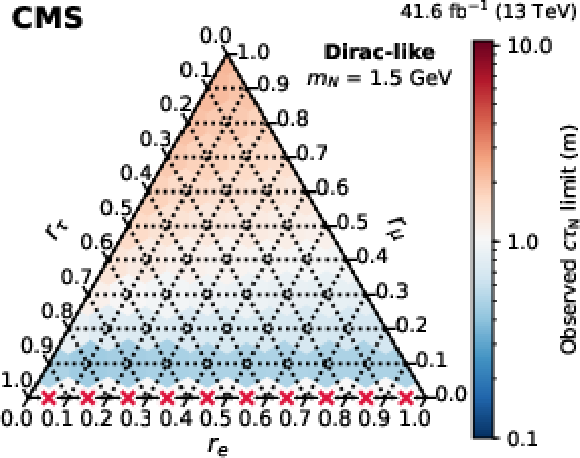
png pdf |
Figure 11-d:
Observed 95% CL lower limits on $ c\tau_{\mathrm{N}} $ as functions of the mixing ratios ($ r_\mathrm{e} $, $ r_\mu $, $ r_\tau $) for fixed N masses of 1 GeV (upper row), 1.5 GeV (middle row), and 2 GeV (lower row), in the Majorana (left column) and Dirac-like (right column) scenarios. The red crosses indicate that there is no exclusion found for that point. The orientation of the value markers on each axis identifies the associated internal lines on the plot. |
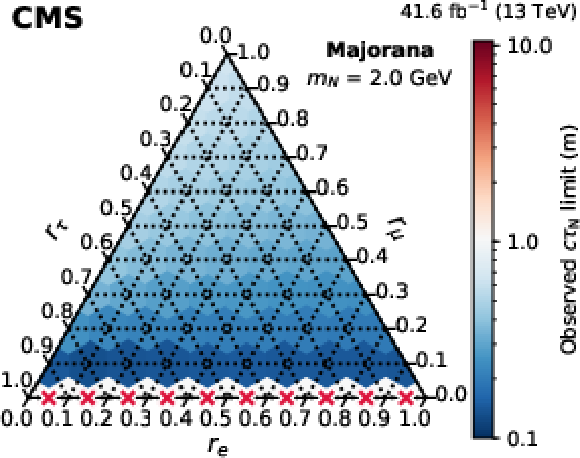
png pdf |
Figure 11-e:
Observed 95% CL lower limits on $ c\tau_{\mathrm{N}} $ as functions of the mixing ratios ($ r_\mathrm{e} $, $ r_\mu $, $ r_\tau $) for fixed N masses of 1 GeV (upper row), 1.5 GeV (middle row), and 2 GeV (lower row), in the Majorana (left column) and Dirac-like (right column) scenarios. The red crosses indicate that there is no exclusion found for that point. The orientation of the value markers on each axis identifies the associated internal lines on the plot. |
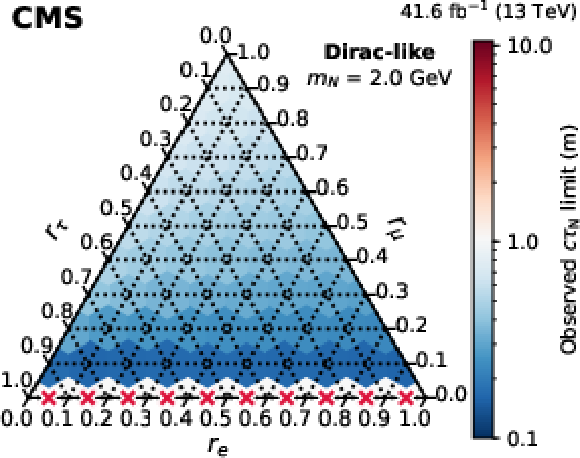
png pdf |
Figure 11-f:
Observed 95% CL lower limits on $ c\tau_{\mathrm{N}} $ as functions of the mixing ratios ($ r_\mathrm{e} $, $ r_\mu $, $ r_\tau $) for fixed N masses of 1 GeV (upper row), 1.5 GeV (middle row), and 2 GeV (lower row), in the Majorana (left column) and Dirac-like (right column) scenarios. The red crosses indicate that there is no exclusion found for that point. The orientation of the value markers on each axis identifies the associated internal lines on the plot. |
| Tables | |
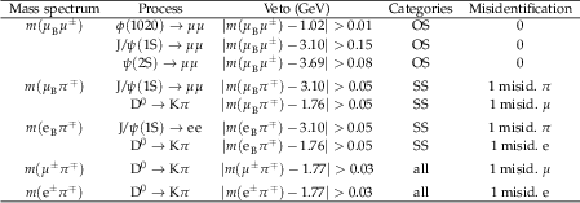
png pdf |
Table 1:
List of considered SM resonances and the corresponding vetoes in the various two-particle invariant mass spectra. The first seven lines consider any possible opposite-sign pair comprising the lepton originating from the B decay and either of the displaced $ \ell^{\pm} $ and $ \pi^{\mp} $. Events that fail the veto conditions are removed from the analysis. The last two lines pertain to the displaced $ \ell^{\pm}\pi^{\mp} $ candidate and indicate that the signal extraction is not performed and exclusion limits are not provided for $ m_\mathrm{N} $ in the vetoed regions. The presence of misidentified particles is also indicated. For the $ \mathrm{D^0} $ meson vetoes, the mass range is adjusted to account for the incorrect mass hypothesis assigned to the misidentified particle. |
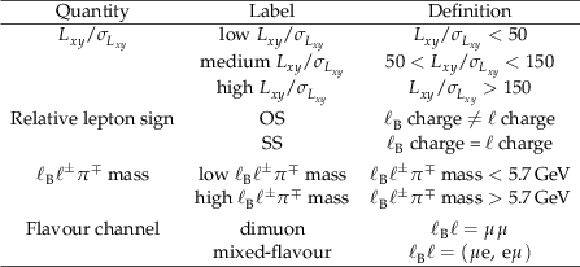
png pdf |
Table 2:
Summary of the event categorisation. The events are classified into 24 mutually exclusive categories. |
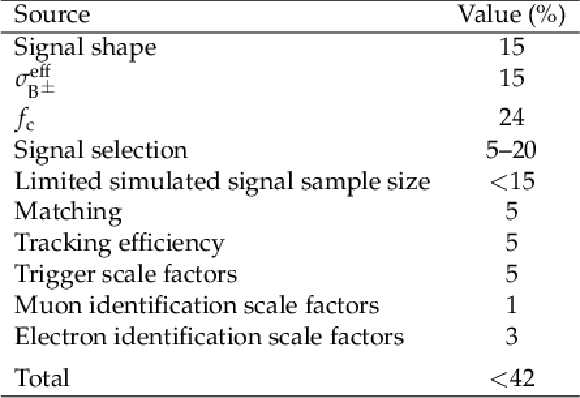
png pdf |
Table 3:
Sources of systematic uncertainty affecting the expected signal event yield. The ranges given correspond to the uncertainties across the different event categories. The uncertainty in the integrated luminosity is not reported as it is incorporated in the uncertainty in the cross section measurement used to normalize the signal. |
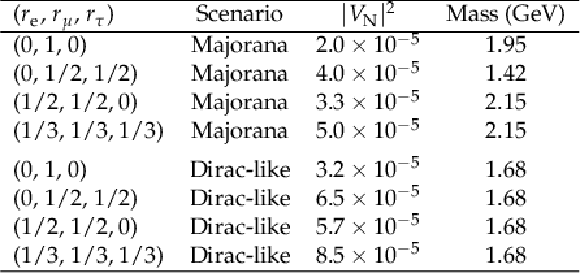
png pdf |
Table 4:
Summary of the most stringent upper limits on $ |V_\mathrm{N}|^2 $ at 95% CL. For each scenario, the minimum excluded value of $ |V_\mathrm{N}|^2 $ is reported together with the mass at which it occurs. |

png pdf |
Table 5:
Summary of the most stringent lower limits on $ c\tau_{\mathrm{N}} $ at 95% CL, obtained for the mixing scenario ($r_\mathrm{e}$, $\,r_\mu$, $\,r_\tau$) $=$ (0, 1, 0). The maximum excluded value of $ c\tau_{\mathrm{N}} $ is reported for masses $ m_\mathrm{N} = $ 1.0, 1.5 and 2.0, and for the Majorana and Dirac-like scenarios. |
| Summary |
| A search for long-lived heavy neutrinos, N, in the leptonic and semileptonic decays of B mesons produced in proton-proton collisions at $ \sqrt{s}= $ 13 TeV has been performed. The search uses a special data sample, referred to as the B-parking data sample, accumulated by the CMS experiment during 2018. The sample corresponds to an integrated luminosity of 41.6 fb$ ^{-1} $ and contains of order 10^${10}$ $ \mathrm{b} \overline{\mathrm{b}} $ events. The search is based on the process $ {\mathrm{B}}\to\ell_{\mathrm{B}}\mathrm{N} \mathrm{X} $, $ \mathrm{N}\to \ell^{\pm}\pi^{\mp} $, where the charged leptons $ \ell_{\mathrm{B}} $ and $ \ell $ are required to be $ \ell_{\mathrm{B}}\ell=\mu\mu,\,\mu\mathrm{e},\,\mathrm{or }\mathrm{e}\mu $; the hadronic recoil system, X, is treated inclusively and is not reconstructed and the $ {\mathrm{B}} =({\mathrm{B}}_{{\mathrm{u}}} $, $ {\mathrm{B}}_{{\mathrm{d}}} $, $ {\mathrm{B}}_{{\mathrm{s}}} $, $ {\mathrm{B}}_{{\mathrm{c}}}) $ decays are summed. Results are reported for the N mass range 1 $ < m_{\mathrm{N}} < $ 3 GeV. The main elements of the search signature are (i) two charged leptons, at least one of which must be a muon that satisfies the B-parking trigger requirements, (ii) a displaced vertex associated with the $ \mathrm{N}\to\ell^{\pm}\pi^{\mp} $ decay, and (iii) a peak in the invariant mass distribution of the $ \ell^{\pm}\pi^{\mp} $ system consistent with the expected signal shape. Backgrounds, which arise primarily from strong-interaction processes, are suppressed using a parametric neural network that considers a broad range of event properties. A search for N states is performed using simultaneous maximum likelihood fits to the $ \ell^{\pm}\pi^{\mp} $ invariant mass distributions in 24 mutually exclusive event categories. No significant excess of events over the SM background is observed in any of the fit regions. The results are interpreted for the separate hypotheses of a Majorana or Dirac-like particle as (i) upper limits at 95% CL on $ |V_{\mathrm{N}}|^2 $ as functions of $ m_{\mathrm{N}} $, for representative scenarios specified by different values of the mixing ratios $ r_\mathrm{e} $, $ r_\mu $, and $ r_\tau $; and as (ii) lower limits at 95% CL on $ c\tau_{\mathrm{N}} $ for 66 combinations of $ r_\mathrm{e} $, $ r_\mu $, and $ r_\tau $ for signal masses $ m_\mathrm{N} = $ 1.0, 1.5, and 2.0 GeV. The most stringent limits are $ |V_{\mathrm{N}}|^2 < $ 2.0 $\times$ 10$^{-5} $ and $ c\tau_{\mathrm{N}} > $ 10.5 m, obtained for the Majorana and Dirac-like cases, respectively, and for the scenario in which the N mixes exclusively with the muon sector. This search provides the most stringent exclusion limits on $ |V_\mathrm{N}|^2 $ for masses 1 $ < m_\mathrm{N} < $ 1.7 GeV from a collider experiment to date. Assuming the benchmark scenario $ (r_\mathrm{e},\,r_\mu,\,r_\tau) = $ (0, 1, 0) and the Majorana hypothesis, the exclusion is improved by almost one order of magnitude compared to LHCb [25], and by up to a factor of about 2 compared to Belle [15] and the most stringent previous hadron collider result [24]. Furthermore, the first upper limits on $ |V_\mathrm{N}|^2 $ are set for the mass range 1 $ < m_\mathrm{N} < $ 2 GeV for the mixing scenarios $ (r_\mathrm{e},\,r_\mu,\,r_\tau) = $ (0, 1/2, 1/2), (1/2, 1/2, 0), and (1/3, 1/3, 1/3). Finally, lower limits on $ c\tau_{\mathrm{N}} $ in the form of ternary plots for masses $ m_\mathrm{N} \leq $ 2.0 GeV are presented for the first time. |
| Additional Figures | |
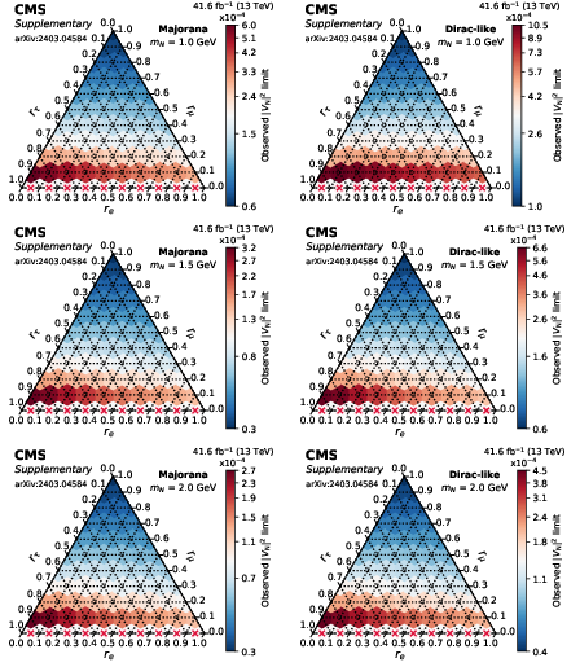
png pdf |
Additional Figure 1:
Observed limits on $ |V_\mathrm{N}|^2 $ as a function of the mixing ratios ($ r_\mathrm{e} $, $ r_\mu $, $ r_\tau $) for fixed N masses of 1 GeV (top row), 1.5 GeV (middle row), and 2 GeV (bottom row), in the Majorana (left column) and Dirac-like (right column) scenarios. The red crosses indicate that there is no exclusion found for that point. The orientation of the value markers on each axis identifies the associated internal lines on the plot. |

png pdf |
Additional Figure 1-a:
Observed limits on $ |V_\mathrm{N}|^2 $ as a function of the mixing ratios ($ r_\mathrm{e} $, $ r_\mu $, $ r_\tau $) for fixed N masses of 1 GeV (top row), 1.5 GeV (middle row), and 2 GeV (bottom row), in the Majorana (left column) and Dirac-like (right column) scenarios. The red crosses indicate that there is no exclusion found for that point. The orientation of the value markers on each axis identifies the associated internal lines on the plot. |
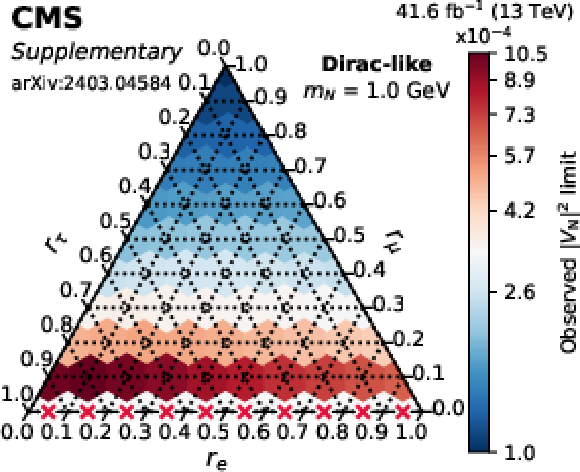
png pdf |
Additional Figure 1-b:
Observed limits on $ |V_\mathrm{N}|^2 $ as a function of the mixing ratios ($ r_\mathrm{e} $, $ r_\mu $, $ r_\tau $) for fixed N masses of 1 GeV (top row), 1.5 GeV (middle row), and 2 GeV (bottom row), in the Majorana (left column) and Dirac-like (right column) scenarios. The red crosses indicate that there is no exclusion found for that point. The orientation of the value markers on each axis identifies the associated internal lines on the plot. |
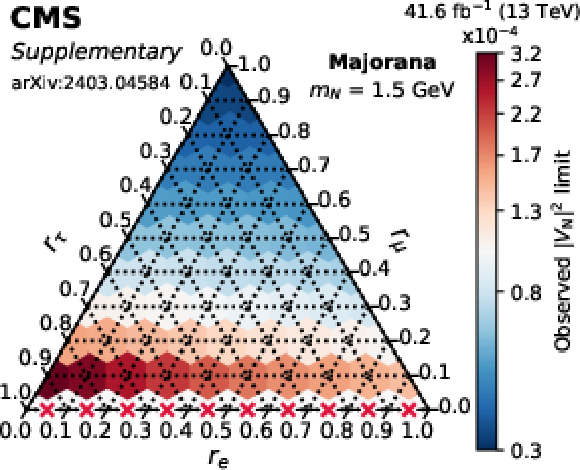
png pdf |
Additional Figure 1-c:
Observed limits on $ |V_\mathrm{N}|^2 $ as a function of the mixing ratios ($ r_\mathrm{e} $, $ r_\mu $, $ r_\tau $) for fixed N masses of 1 GeV (top row), 1.5 GeV (middle row), and 2 GeV (bottom row), in the Majorana (left column) and Dirac-like (right column) scenarios. The red crosses indicate that there is no exclusion found for that point. The orientation of the value markers on each axis identifies the associated internal lines on the plot. |

png pdf |
Additional Figure 1-d:
Observed limits on $ |V_\mathrm{N}|^2 $ as a function of the mixing ratios ($ r_\mathrm{e} $, $ r_\mu $, $ r_\tau $) for fixed N masses of 1 GeV (top row), 1.5 GeV (middle row), and 2 GeV (bottom row), in the Majorana (left column) and Dirac-like (right column) scenarios. The red crosses indicate that there is no exclusion found for that point. The orientation of the value markers on each axis identifies the associated internal lines on the plot. |
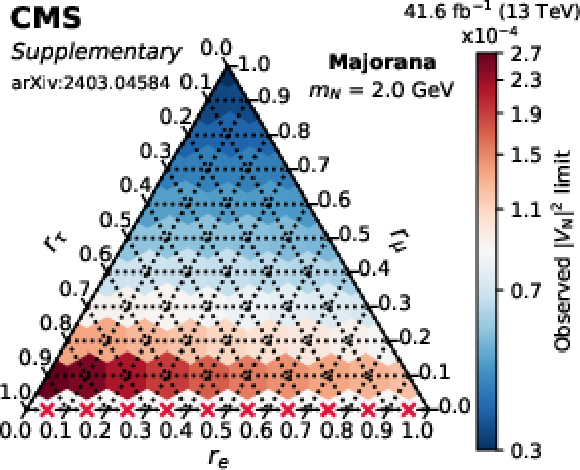
png pdf |
Additional Figure 1-e:
Observed limits on $ |V_\mathrm{N}|^2 $ as a function of the mixing ratios ($ r_\mathrm{e} $, $ r_\mu $, $ r_\tau $) for fixed N masses of 1 GeV (top row), 1.5 GeV (middle row), and 2 GeV (bottom row), in the Majorana (left column) and Dirac-like (right column) scenarios. The red crosses indicate that there is no exclusion found for that point. The orientation of the value markers on each axis identifies the associated internal lines on the plot. |
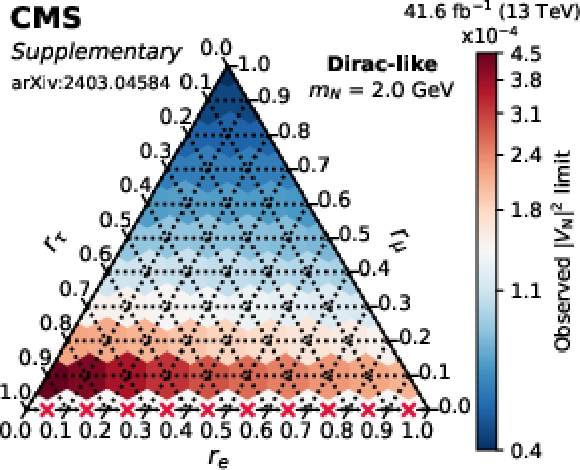
png pdf |
Additional Figure 1-f:
Observed limits on $ |V_\mathrm{N}|^2 $ as a function of the mixing ratios ($ r_\mathrm{e} $, $ r_\mu $, $ r_\tau $) for fixed N masses of 1 GeV (top row), 1.5 GeV (middle row), and 2 GeV (bottom row), in the Majorana (left column) and Dirac-like (right column) scenarios. The red crosses indicate that there is no exclusion found for that point. The orientation of the value markers on each axis identifies the associated internal lines on the plot. |
| References | ||||
| 1 | S. Bilenky | Neutrino oscillations: From a historical perspective to the present status | NPB 908 (2016) 2 | 1602.00170 |
| 2 | J. Silk et al | Particle dark matter: observations, models and searches | Cambridge Univ. Press, Cambridge, ISBN~978-1-107-65392-4, 2010 link |
|
| 3 | G. R. Farrar and M. E. Shaposhnikov | Baryon asymmetry of the universe in the standard electroweak theory | PRD 50 (1994) 774 | hep-ph/9305275 |
| 4 | T. Asaka, S. Blanchet, and M. Shaposhnikov | The nuMSM, dark matter and neutrino masses | PLB 631 (2005) 151 | hep-ph/0503065 |
| 5 | T. Asaka and M. Shaposhnikov | The $ \nu $MSM, dark matter and baryon asymmetry of the universe | PLB 620 (2005) 17 | hep-ph/0505013 |
| 6 | S. Dodelson and L. M. Widrow | Sterile-neutrinos as dark matter | PRL 72 (1994) 17 | hep-ph/9303287 |
| 7 | M. Fukugita and T. Yanagida | Baryogenesis without grand unification | PLB 174 (1986) 45 | |
| 8 | P. Minkowski | $ \mu \to e\gamma $ at a rate of one out of $ 10^{9} $ muon decays? | PLB 67 (1977) 421 | |
| 9 | K. N. Abazajian et al. | Light sterile neutrinos: a white paper | fermilab pub, 2012 | 1204.5379 |
| 10 | K. Bondarenko, A. Boyarsky, D. Gorbunov, and O. Ruchayskiy | Phenomenology of GeV-scale heavy neutral leptons | JHEP 11 (2018) 032 | 1805.08567 |
| 11 | CHARM Collaboration | A search for decays of heavy neutrinos in the mass range 0.5 - 2.8 GeV | PLB 166 (1986) 473 | |
| 12 | NuTeV-E815 Collaboration | Search for neutral heavy leptons in a high-energy neutrino beam | PRL 83 (1999) 4943 | hep-ex/9908011 |
| 13 | R. Barouki, G. Marocco, and S. Sarkar | Blast from the past II: Constraints on heavy neutral leptons from the BEBC WA66 beam dump experiment | SciPost Phys. 13 (2022) 118 | 2208.00416 |
| 14 | WA66 Collaboration | Search for heavy neutrino decays in the BEBC beam dump experiment | PLB 160 (1985) 207 | |
| 15 | Belle Collaboration | Search for heavy neutrinos at Belle | PRD 87 (2013) 071102 | 1301.1105 |
| 16 | BABAR Collaboration | Search for heavy neutral leptons using tau lepton decays at BABAR | PRD 107 (2023) 052009 | 2207.09575 |
| 17 | ATLAS Collaboration | Search for heavy neutral leptons in decays of $ W $ bosons produced in 13 TeV $ pp $ collisions using prompt and displaced signatures with the ATLAS detector | JHEP 10 (2019) 265 | 1905.09787 |
| 18 | ATLAS Collaboration | Search for heavy neutral leptons in decays of W bosons using a dilepton displaced vertex in $ \sqrt{s}= $ 13 TeV pp collisions with the ATLAS detector | PRL 131 (2023) 061803 | 2204.11988 |
| 19 | CMS Collaboration | Search for heavy neutral leptons in events with three charged leptons in proton-proton collisions at $ \sqrt{s} = $ 13 TeV | PRL 120 (2018) 221801 | CMS-EXO-17-012 1802.02965 |
| 20 | CMS Collaboration | Search for heavy Majorana neutrinos in same-sign dilepton channels in proton-proton collisions at $ \sqrt{s}= $ 13 TeV | JHEP 01 (2019) 122 | CMS-EXO-17-028 1806.10905 |
| 21 | CMS Collaboration | Search for heavy neutrinos and third-generation leptoquarks in hadronic states of two $ \tau $ leptons and two jets in proton-proton collisions at $ \sqrt{s} = $ 13 TeV | JHEP 03 (2019) 170 | CMS-EXO-17-016 1811.00806 |
| 22 | CMS Collaboration | Search for long-lived heavy neutral leptons with displaced vertices in proton-proton collisions at $ \sqrt{\mathrm{s}} $ =13 TeV | JHEP 07 (2022) 081 | CMS-EXO-20-009 2201.05578 |
| 23 | CMS Collaboration | Search for long-lived heavy neutral leptons with lepton flavour conserving or violating decays to a jet and a charged lepton | link | CMS-EXO-21-013 2312.07484 |
| 24 | CMS Collaboration | Search for long-lived heavy neutral leptons decaying in the CMS muon detectors in proton-proton collisions at $ \sqrt{s} $ = 13 TeV | 2, 2024 | CMS-EXO-22-017 2402.18658 |
| 25 | LHCb Collaboration | Search for Majorana neutrinos in $ B^- \to \pi^+\mu^-\mu^- $ decays | PRL 112 (2014) 131802 | 1401.5361 |
| 26 | LHCb Collaboration | Search for heavy neutral leptons in $ W^+\to\mu^{+}\mu^{\pm}\text{jet} $ decays | EPJC 81 (2021) 248 | 2011.05263 |
| 27 | CMS Collaboration | Enriching the physics program of the CMS experiment via data scouting and data parking | Submitted to Phys. Rep, 2024 | CMS-EXO-23-007 2403.16134 |
| 28 | CMS Collaboration | Test of lepton flavor universality in B$ ^{\pm} \to $ K$ ^{\pm}\mu^+\mu^- $ and B$ ^{\pm} \to $ K$ ^{\pm} $e$ ^+ $e$ ^- $ decays in proton-proton collisions at $ \sqrt{s} $ = 13 TeV | link | CMS-BPH-22-005 2401.07090 |
| 29 | F. F. Deppisch, P. S. Bhupal Dev, and A. Pilaftsis | Neutrinos and Collider Physics | New J. Phys. 17 (2015) 075019 | 1502.06541 |
| 30 | Particle Data Group | Review of particle physics | PTEP 2022 (2022) 083C01 | |
| 31 | M. Drewes | The phenomenology of right handed neutrinos | Int. J. Mod. Phys. E 22 (2013) 1330019 | 1303.6912 |
| 32 | P. Hernández, J. Jones-Pérez, and O. Suarez-Navarro | Majorana vs pseudo-Dirac neutrinos at the ILC | EPJC 79 (2019) 220 | 1810.07210 |
| 33 | CMS Collaboration | HEPData record for this analysis | link | |
| 34 | CMS Collaboration | Performance of the CMS Level-1 trigger in proton-proton collisions at $ \sqrt{s} = $ 13 TeV | JINST 15 (2020) P10017 | CMS-TRG-17-001 2006.10165 |
| 35 | CMS Collaboration | The CMS trigger system | JINST 12 (2017) P01020 | CMS-TRG-12-001 1609.02366 |
| 36 | CMS Collaboration | The CMS experiment at the CERN LHC | JINST 3 (2008) S08004 | |
| 37 | CMS Collaboration | CMS luminosity measurement for the 2018 data-taking period at $ \sqrt{s} = $ 13 TeV | CMS Physics Analysis Summary, 2019 link |
CMS-PAS-LUM-18-002 |
| 38 | LHCb Collaboration | Measurement of the $ B_c^- $ meson production fraction and asymmetry in 7 and 13 TeV $ pp $ collisions | PRD 100 (2019) 112006 | 1910.13404 |
| 39 | T. Sjöstrand et al. | An introduction to PYTHIA 8.2 | Comput. Phys. Commun. 191 (2015) 159 | 1410.3012 |
| 40 | CMS Collaboration | Extraction and validation of a new set of CMS PYTHIA8 tunes from underlying-event measurements | EPJC 80 (2020) 4 | CMS-GEN-17-001 1903.12179 |
| 41 | NNPDF Collaboration | Parton distributions from high-precision collider data | EPJC 77 (2017) 663 | 1706.00428 |
| 42 | D. J. Lange | The EvtGen particle decay simulation package | NIM A 462 (2001) 152 | |
| 43 | C.-H. Chang, J.-X. Wang, and X.-G. Wu | BCVEGPY2.0: A Upgrade version of the generator BCVEGPY with an addendum about hadroproduction of the P-wave B(c) states | Comput. Phys. Commun. 174 (2006) 241 | hep-ph/0504017 |
| 44 | GEANT4 Collaboration | GEANT 4---a simulation toolkit | NIM A 506 (2003) 250 | |
| 45 | CMS Collaboration | Performance of the CMS muon detector and muon reconstruction with proton-proton collisions at $ \sqrt{s}= $ 13 TeV | JINST 13 (2018) P06015 | CMS-MUO-16-001 1804.04528 |
| 46 | CMS Collaboration | Particle-flow reconstruction and global event description with the CMS detector | JINST 12 (2017) P10003 | CMS-PRF-14-001 1706.04965 |
| 47 | CMS Collaboration | CMS tracking performance results from early LHC operation | EPJC 70 (2010) 1165 | CMS-TRK-10-001 1007.1988 |
| 48 | CMS Collaboration | Electron and photon reconstruction and identification with the CMS experiment at the CERN LHC | JINST 16 (2021) P05014 | CMS-EGM-17-001 2012.06888 |
| 49 | K. Prokofiev and T. Speer | A kinematic and a decay chain reconstruction library | in 14th International Conference on Computing in High-Energy and Nuclear Physics, 2005 | |
| 50 | P. Baldi et al. | Parameterized neural networks for high-energy physics | EPJC 76 (2016) 235 | 1601.07913 |
| 51 | K. Fukushima | Visual feature extraction by a multilayered network of analog threshold elements | IEEE Transactions on Systems Science and Cybernetics 5 (1969) 322 | |
| 52 | F. Chollet et al. | Keras | link | |
| 53 | M. Abadi et al. | TensorFlow: A system for large-scale machine learning | in Proceedings of the 12th USENIX Conference on Operating Systems Design and Implementation, OSDI'16, USENIX Association, 2016 | 1605.08695 |
| 54 | D. P. Kingma and J. Ba | Adam: A method for stochastic optimization | 1412.6980 | |
| 55 | F. Pedregosa et al. | Scikit-learn: Machine learning in Python | J. Mach. Learn. Res. 12 (2011) 2825 | 1201.0490 |
| 56 | CMS Collaboration | Measurement of the total and differential inclusive $ B^+ $ hadron cross sections in pp collisions at $ \sqrt{s} $ = 13 TeV | PLB 771 (2017) 435 | CMS-BPH-15-004 1609.00873 |
| 57 | M. J. Oreglia | A study of the reactions $ \psi^\prime \to \gamma \gamma \psi $ | PhD thesis, Stanford University, . SLAC Report SLAC-R-236, 1980 link |
|
| 58 | J. E. Gaiser | Charmonium spectroscopy from radiative decays of the J/$ \psi $ and $ \psi^\prime $ | PhD thesis, Stanford University, SLAC Report SLAC-R-255, 1982 | |
| 59 | P. D. Dauncey, M. Kenzie, N. Wardle, and G. J. Davies | Handling uncertainties in background shapes: the discrete profiling method | JINST 10 (2015) P04015 | 1408.6865 |
| 60 | R. A. Fisher | On the mathematical foundations of theoretical statistics | Phil. Trans. Roy. Soc. Lond. A 222 (1922) 309 | |
| 61 | S. S. Wilks | The large-sample distribution of the likelihood ratio for testing composite hypotheses | Annals Math. Statist. 9 (1938) 60 | |
| 62 | A. L. Read | Presentation of search results: The $ CL_s $ technique | JPG 28 (2002) 2693 | |
| 63 | G. Cowan, K. Cranmer, E. Gross, and O. Vitells | Asymptotic formulae for likelihood-based tests of new physics | EPJC 71 (2011) 1554 | 1007.1727 |
| 64 | M. Drewes, J. Klarić, and J. López-Pavón | New benchmark models for heavy neutral lepton searches | EPJC 82 (2022) 1176 | 2207.02742 |
| 65 | B. Shuve and M. E. Peskin | Revision of the LHCb limit on Majorana neutrinos | PRD 94 (2016) 113007 | 1607.04258 |

|
Compact Muon Solenoid LHC, CERN |

|

|

|

|

|

|